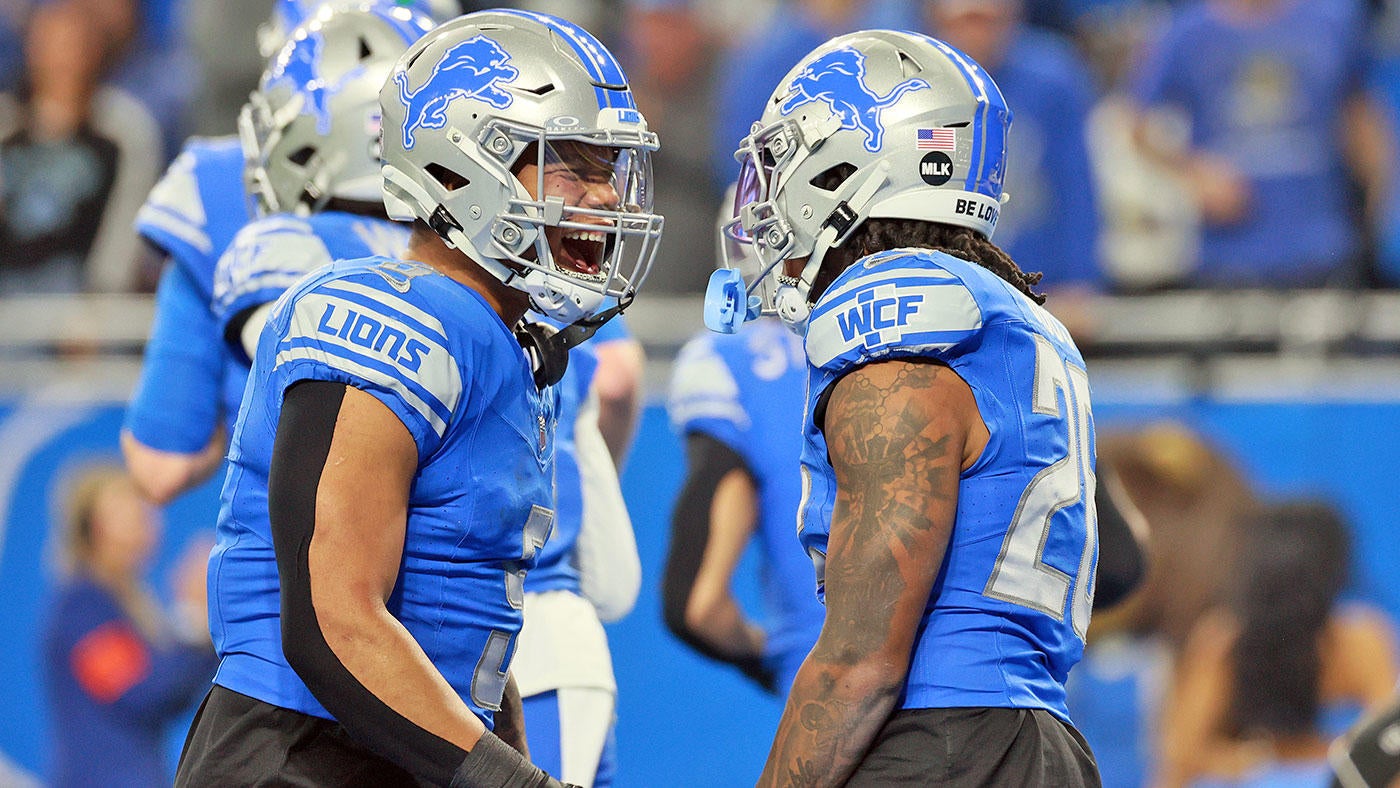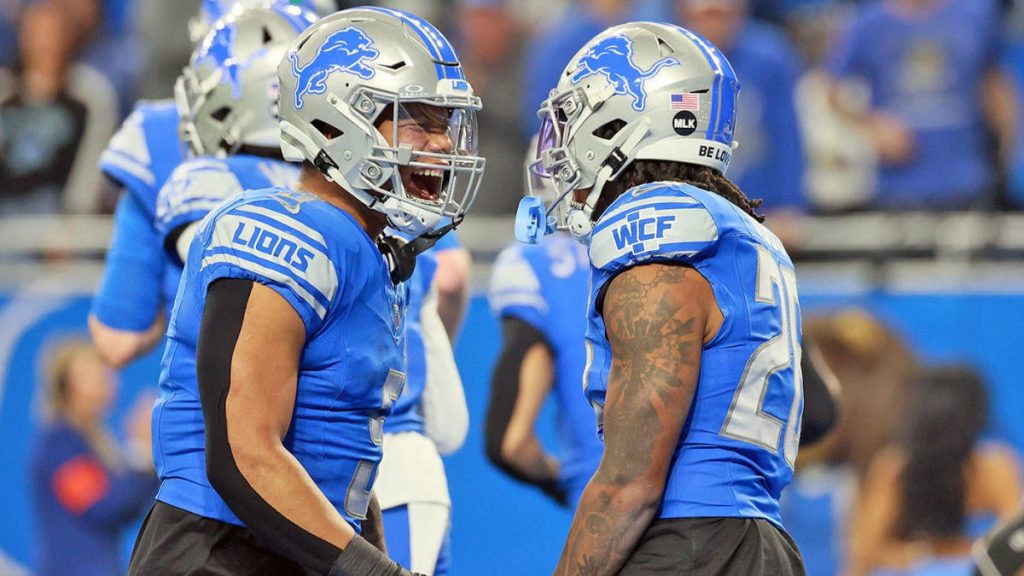
Heading into Week 10, the Detroit Lions look like perhaps the best team in the NFL. Their offense can at times feel unstoppable; they have dropped 40-plus points in three different games, and have been held below 20 just once. Since returning from their Week 5 bye, they have scored a touchdown or field goal on 24 of 44 drives — and four of the drives on which they didn’t score were ones where they were merely running out the clock on either the half or the game.
And in an age where the passing game is king, the most impressive and difficult-to-stop aspect of Detroit’s offense might actually be its ground attack. The Lions are so good at running the ball that it’s almost hard to believe.
Their 0.11 EPA per play mark, via Tru Media, would rank as a top-10 passing offense this season. As if that weren’t absurd enough, consider this: Since the league expanded to 32 teams back in 2002, there have been 736 team-seasons. This Lions team ranks THIRD among that group of 736 in rushing EPA per play on hand-offs to running backs. The only teams ahead of them are the 2006 Chargers (a.k.a. LaDainian Tomlinson’s record-setting touchdown season) and 2002 Vikings (honestly I’ve got no explanation for this one; it was just a perfectly average Michael Bennett season where No. 2 running back Moe Williams also popped off for 11 touchdowns).
Detroit’s 5.3 yards per carry average is tied for seventh-best among that same group of teams. Indicating the profound strength of its offensive line, the unit’s 1.97 yards per carry before contact average is 10th-best since 2017, which is the farthest back for which that data exists. The Lions also have the 10th-lowest share of negative runs (13.5%) during that time and the seventh-highest share of runs that gained five or more yards (40.8%). The lanes that the group up front clear for David Montgomery and Jahmyr Gibbs are just massive. They have so much room to run.
And the Lions don’t just run it one way. They somehow manage to major in every run concept. According to Tru Media, they rank second in yards per carry on zone runs (5.7), sixth in yards per carry on “man” runs (4.8) and second in yards per carry on misdirection runs (6.0). That makes no sense. You aren’t supposed to be able to do that. But the Lions, thanks to the combination of their line, their backs and offensive coordinator Ben Johnson’s play designs, actually do.
Befitting that multi-major aspect of their offense, the Lions get very different things from their two backs. There are 47 running backs who have at least 50 carries this season. Among those backs, here is how Montgomery and Gibbs have performed in yards per carry, success rate, yards before and after contact per attempt and the share of runs stopped before the line of scrimmage, that gained five or more yards or that created an explosive gain:
| YPC | 25 | 1 |
| Success | 2 | 4 |
| YBCO/Att | 30 | 1 |
| YCO/Att | 13 | 14 |
| Neg Yds % | 14 | 2 |
| 5+ Yds % | 7 | 5 |
| Explosive % | 30 | 2 |
Montgomery is a grinder, as we saw in incredible form last week against the Packers. He’s not necessarily going to get you the explosive plays, but he is going to get everything that is blocked and a bit more because of his vision and especially his physicality.
There are very few running backs who can just drop their shoulders and power through tackles of all kinds in the way Montgomery does. Among those 47 backs with 50-plus carries, Montgomery ranks 14th in avoided-tackle rate (24.5%), via Tru Media, and he does it almost entirely through power. According to NFL Pro, Montgomery has yet to hit 20 miles per hour on any of his runs, and among the group of backs for whom that is true, only James Conner, Josh Jacobs and Jonathan Taylor have gained more yards over expectation.
That said, it’s not all about his power and his ability to run through people. Montgomery has also shown excellent vision, and the patience to find holes that open up late in the down. Those aren’t necessarily the traits that come to mind when you picture Montgomery grinding out the tough yards or bowling over defenders; but they are right there, all over the tape. His jump cut, in particular, is helpful at allowing him to shift from one hole to the next and then he can just make himself skinny to get through it and create more yards than it initially looked like were available to him.
And then there’s Gibbs, who is basically the exact inverse of Montgomery. This guy just zooms right around and right past defenders, and they look completely helpless as he leaves them in his week. He is so efficient in his movements. According to NFL.com’s NextGen Stats, Gibbs is the sixth-most north-south runner in the NFL, running 3.18 yards for every actual yard he gains. (The NextGen Stats account for horizontal yards.) Whenever he spots a hole, he is just flat-out gone and there is basically nothing that the defense can do about it.
Like his backfield-mate, though, Gibbs is not just a one-trick pony. He can find rushing lanes with his vision. He can run through tackles just as well as he runs around or away from them. And he can finish runs with surprising amounts of power, like Montgomery. It’s all there. I mean, you don’t just average (an NFL-best) 6.4 yards per carry by accident. You have to be able to do everything. And he can.
Heading into their Sunday night matchup with a Houston Texans defense that ranks among the best in the NFL against the run, the Lions honestly just do not have that much to worry about when it comes to imposing their will on the ground. They have arguably the league’s best line, and probably its premier thunder-and-lightning duo. And they are all put in position to succeed by one of the NFL’s best play-callers. It’s an extremely enviable place to be.
